Filipino jackfruit adobo offers a vibrant vegan twist on a cherished regional dish, highlighting the Philippines’ rich culinary heritage. Made with young jackfruit, it mimics shredded meat with a savory, tangy flavor from traditional ingredients like soy sauce, vinegar, garlic, and native spices. This dish showcases regional variations and sustainable practices, emphasizing local ingredients and creative techniques. If you keep exploring, you’ll discover how to craft this delicious, eco-friendly adaptation that honors culture and innovation.
Key Takeaways
- Filipino jackfruit adobo showcases regional variations through native spices like lemongrass, calamansi, and regional cooking techniques.
- The dish embodies Filipino resilience by using plant-based ingredients like young jackfruit as a sustainable meat substitute.
- Different regions incorporate local ingredients such as coconut milk or siling labuyo, creating unique flavor profiles.
- Creative cooking methods like smoking or caramelizing elevate vegan jackfruit adobo, highlighting culinary innovation.
- Served with regional accompaniments like jasmine rice, pickled vegetables, and tropical fruits, emphasizing local flavors and cultural identity.
The Origins and Cultural Significance of Adobo in the Philippines
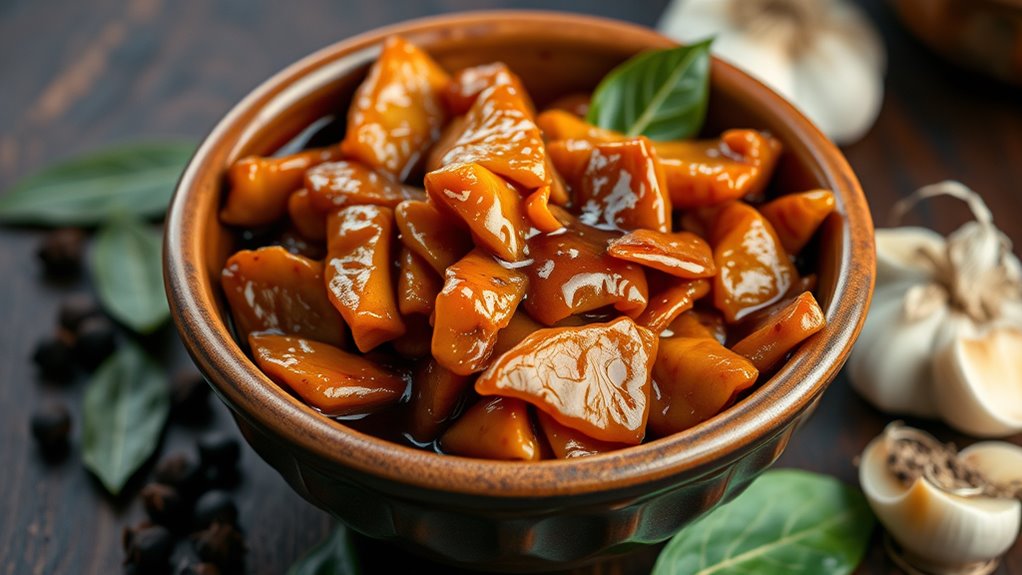
Adobo is more than just a popular Filipino dish; it’s a culinary symbol deeply rooted in the country’s history and culture. Its adobo history dates back centuries, believed to have been influenced by Malay, Chinese, and Spanish cooking traditions. This versatile dish embodies Filipino resilience and resourcefulness, as it uses simple ingredients like vinegar, soy sauce, garlic, and spices to preserve meat and extend its shelf life. This preservation method is a clear example of traditional food preservation, which has been essential for Filipino households. The cultural significance of adobo goes beyond sustenance; it represents Filipino identity and hospitality. Every household has its own version, reflecting regional flavors and family traditions. Over time, adobo has become a national icon, celebrated for its rich history and ability to unite communities through shared culinary heritage. Additionally, the inclusion of indigenous ingredients like native spices highlights its deep cultural roots and regional variations. Recognizing the culinary fusion present in adobo underscores its role as a symbol of Filipino adaptability and cultural diversity. Its preparation methods and regional adaptations also serve as a cultural expression, showcasing local ingredients and culinary techniques that vary across the Philippines. Moreover, the diversity of regional styles demonstrates how food can act as a cultural identifier, reinforcing local identities.
Why Young Jackfruit Is a Perfect Meat Substitute
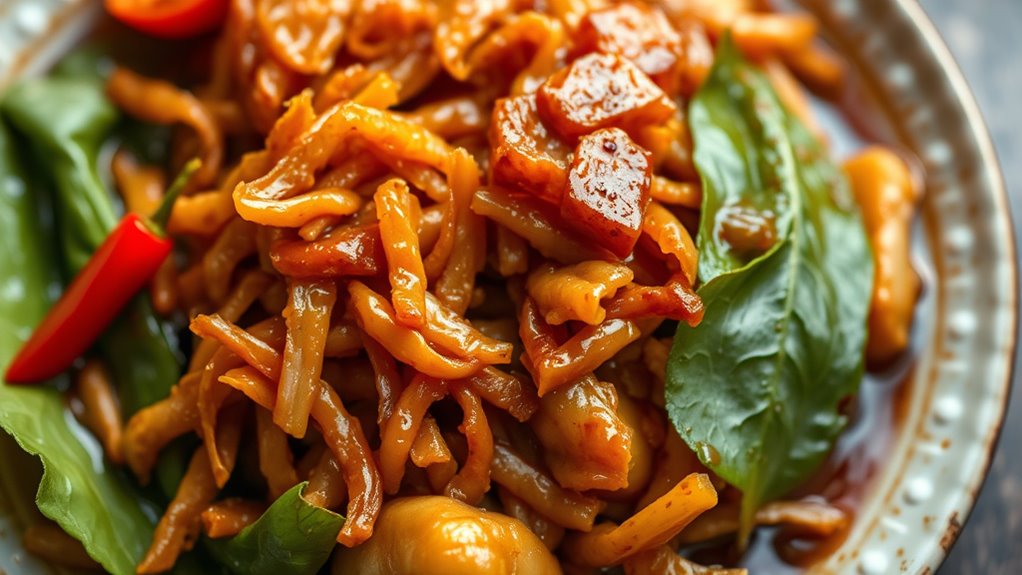
You’ll find that young jackfruit has a texture remarkably similar to meat, making it a versatile choice for plant-based dishes. It’s packed with nutrients that support your health, offering a tasty and nourishing alternative. Plus, choosing jackfruit helps reduce environmental impact, making it an eco-friendly option for conscious eaters. Incorporating sustainable ingredients like jackfruit aligns with environmentally responsible eating habits. Additionally, embracing such plant-based alternatives can positively influence your mental and emotional well-being by fostering a sense of purpose and aligned values. Understanding keto diet principles can further enhance your appreciation for plant-based options that support health and sustainability. Proper preparation and cooking techniques, such as seasoning and marinating, can elevate the flavor profile of jackfruit dishes and make them even more satisfying.
Texture Similarity to Meat
Young jackfruit has a unique fibrous texture that closely mimics shredded meat, making it an ideal substitute in vegan dishes. Its stringy consistency allows it to absorb flavors well, giving it a realistic meat-like appearance and mouthfeel. Because of its texture, it’s a popular meat alternative for those seeking a satisfying, hearty bite without animal products. As a plant-based protein, young jackfruit provides the bulk and chewiness that meat typically offers, making it versatile for various recipes like adobo, tacos, or stir-fries. Its fibrous strands can be seasoned and cooked to replicate the tenderness and fibrousness of meat, enhancing the overall experience of vegan dishes. In short, young jackfruit’s texture makes it stand out as a convincing, enjoyable meat substitute.
Nutritional Benefits Abundant
Because it is rich in essential nutrients, young jackfruit stands out as a highly nutritious meat alternative. Its protein content helps support muscle growth and repair, making it a valuable addition to plant-based diets. Additionally, young jackfruit offers impressive vitamin richness, providing vitamins like C, A, and several B vitamins that boost your immune system and energy levels. It’s low in calories and fat, yet packed with fiber, aiding digestion and promoting fullness. This combination of nutrients makes young jackfruit an excellent choice for those seeking a healthy, sustainable substitute for meat. Not only does it help meet your nutritional needs, but it also ensures you enjoy a flavorful, satisfying meal without sacrificing health benefits.
Eco-Friendly Food Choice
As more people seek sustainable dietary choices, young jackfruit emerges as an exceptionally eco-friendly meat substitute. Its cultivation supports sustainable farming practices, requiring less water and energy compared to traditional livestock. This makes it a smart option for reducing your environmental footprint. By choosing plant-based diets featuring jackfruit, you help lower greenhouse gas emissions and conserve natural resources. Jackfruit’s versatility allows it to mimic meat textures without the need for intensive resource use. Incorporating it into your meals promotes eco-conscious eating habits and supports a more sustainable food system. Understanding plant-based alternatives can deepen your appreciation for eco-friendly ingredients like jackfruit and their role in reducing environmental harm. Additionally, the sustainable farming practices involved in jackfruit cultivation contribute to healthier ecosystems and biodiversity. As you explore regional vegan dishes, consider young jackfruit not just for flavor but also for its positive impact on the planet. It’s a delicious, responsible choice that aligns with your eco-friendly lifestyle.
Step-by-Step Guide to Preparing Vegan Jackfruit Adobo

To make vegan jackfruit adobo, start by gathering all your ingredients: canned young green jackfruit, soy sauce or coconut aminos, vinegar, garlic, bay leaves, black pepper, and a bit of sugar or maple syrup. Begin by draining and rinsing the jackfruit, then shredding it into bite-sized pieces. In a pot, sauté minced garlic until fragrant, then add the jackfruit and cook for a few minutes. Pour in soy sauce, vinegar, and a splash of water, then toss in bay leaves and black pepper. Let it simmer until the flavors meld and the jackfruit absorbs the sauce. This dish exemplifies vegan sustainability and culinary innovation, transforming humble ingredients into a hearty, flavorful meal that honors regional traditions while promoting eco-conscious eating. Incorporating plant-based ingredients can further enhance the dish’s health benefits and environmental impact. Fostering a plant-based diet not only supports individual health but also contributes positively to global sustainability efforts, emphasizing the importance of sustainable cuisine in modern dietary choices.
Variations and Creative Twists on the Classic Recipe
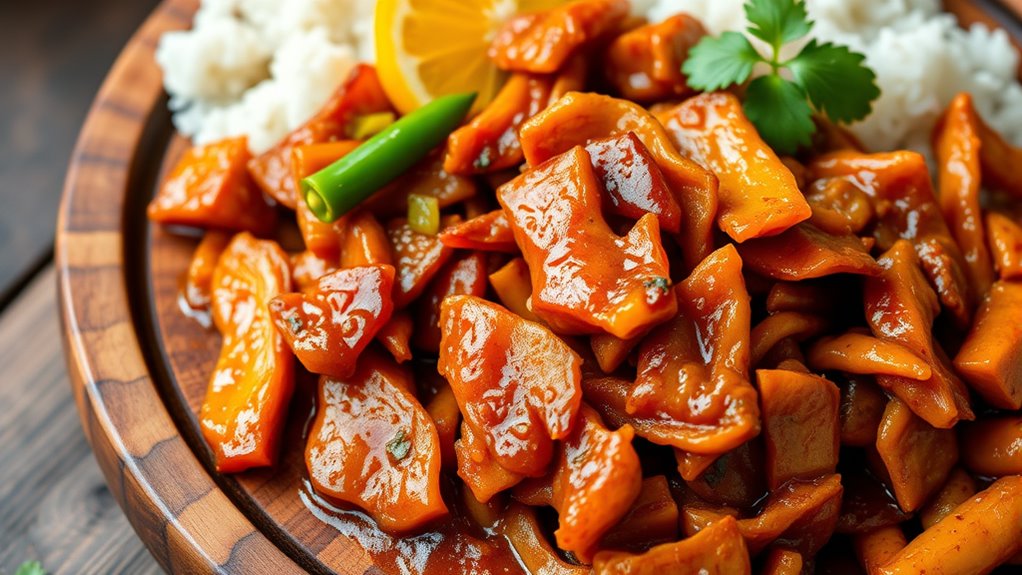
You can elevate classic vegan dishes by adding global flavors or experimenting with local ingredients. Creative twists often involve blending fusion techniques or trying innovative cooking methods. These approaches make traditional recipes more exciting and tailored to diverse tastes. Additionally, understanding regional ingredients can inspire more authentic and flavorful adaptations. Incorporating regional culinary traditions can further enhance the authenticity and appeal of your vegan creations, ensuring they resonate with diverse palates. Paying attention to regional food customs can provide deeper insights into traditional flavor profiles that enrich your culinary experiments. Moreover, considering cultural culinary techniques can help you authentically replicate or adapt recipes while respecting their origins. Residency requirements are crucial to ensure legal compliance when attempting modifications or fusion-style cooking at home or in commercial settings.
Incorporating Global Flavors
Incorporating global flavors into regional vegan dishes opens up a world of exciting possibilities, allowing you to put creative twists on classic recipes. By experimenting with spice blends like cumin, turmeric, or garam masala, you can bring a new depth of flavor. Cultural fusion transforms familiar dishes into vibrant, memorable experiences. Imagine adding a touch of Thai lemongrass or Moroccan harissa to your Filipino jackfruit adobo, creating a fresh palate of tastes. This approach not only celebrates diversity but also elevates your cooking. Here’s a glimpse of how different spice blends evoke emotion:
| Spice Blend | Cultural Inspiration |
|---|---|
| Cumin & Coriander | Middle Eastern flair |
| Smoked Paprika | Spanish warmth |
| Curry Powder | Indian richness |
| Five-Spice | Chinese complexity |
| Za’atar | Middle Eastern zest |
Fusion With Local Ingredients
By using local ingredients to put creative twists on classic vegan dishes, you can elevate familiar recipes into unique culinary experiences. Incorporating local flavor through ingredient fusion allows you to showcase the richness of regional produce and spices. For example, adding tangy calamansi or spicy siling labuyo can enhance the depth of vegan adobo made from jackfruit. You might also experiment with native herbs like lemongrass or pandan for aromatic accents. These ingredient fusions create vibrant, memorable dishes that reflect local culture while offering new taste dimensions. Embracing regional ingredients not only celebrates Filipino culinary heritage but also inspires innovative vegan adaptations. This approach makes your dishes more authentic and exciting, inviting others to explore the diverse flavors that define Filipino cuisine.
Innovative Cooking Techniques
Creative cooking techniques can transform traditional vegan recipes into exciting culinary innovations. By experimenting with methods like smoking, grilling, or caramelizing jackfruit, you add depth and new textures that elevate the classic Filipino adobo. Flavor experimentation is key—you might infuse the dish with unexpected ingredients such as lemongrass, coconut milk, or tangy fruit preserves to create a distinctive twist. Using techniques like marinating the jackfruit in soy sauce and vinegar beforehand enhances its savory profile, while slow-cooking or pressure-cooking can deepen flavors rapidly. These innovative approaches push the boundaries of traditional cooking, making your vegan adobo a modern, creative masterpiece. Embracing culinary innovation allows you to discover exciting variations that appeal to adventurous palates and highlight your personal culinary style.
Nutritional Benefits and Sustainable Aspects of Using Jackfruit
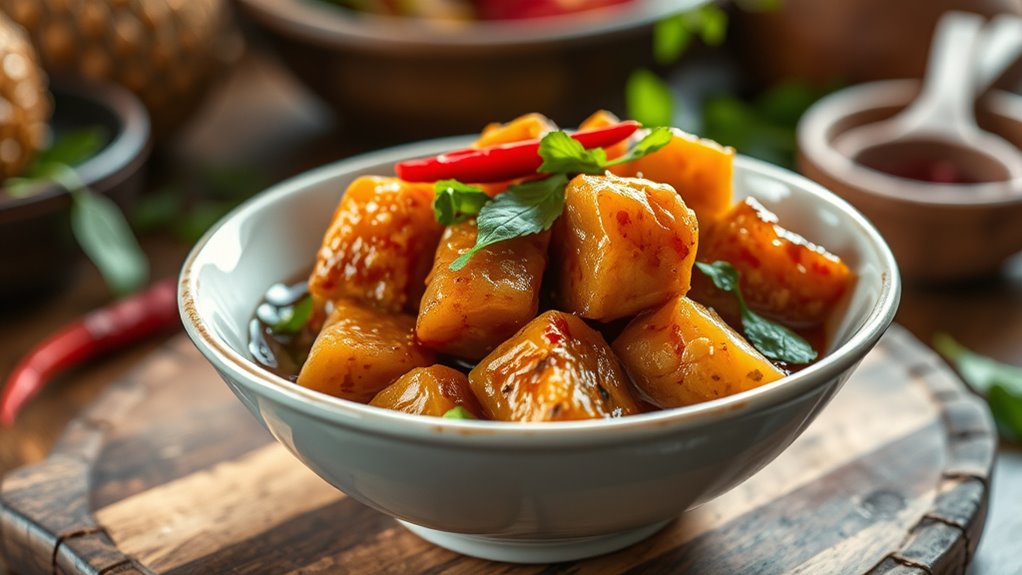
Because of its impressive nutrient profile, jackfruit offers significant health benefits while supporting sustainable food practices. Rich in jackfruit antioxidants, it helps combat oxidative stress, boosting your immune system and promoting overall health. Its high fiber content aids digestion and encourages satiety, making it a great plant-based option. As a crop, jackfruit thrives in sustainable farming systems, requiring minimal water and fertilizers compared to other crops. This reduces environmental impact and preserves soil health. By choosing jackfruit, you contribute to eco-friendly agriculture and reduce reliance on resource-intensive foods. Its versatility and nutritional value make it an excellent choice for those seeking a nutritious, sustainable, and innovative ingredient for vegan dishes like Filipino Jackfruit Adobo.
Pairing Vegan Jackfruit Adobo With Traditional Filipino Sides
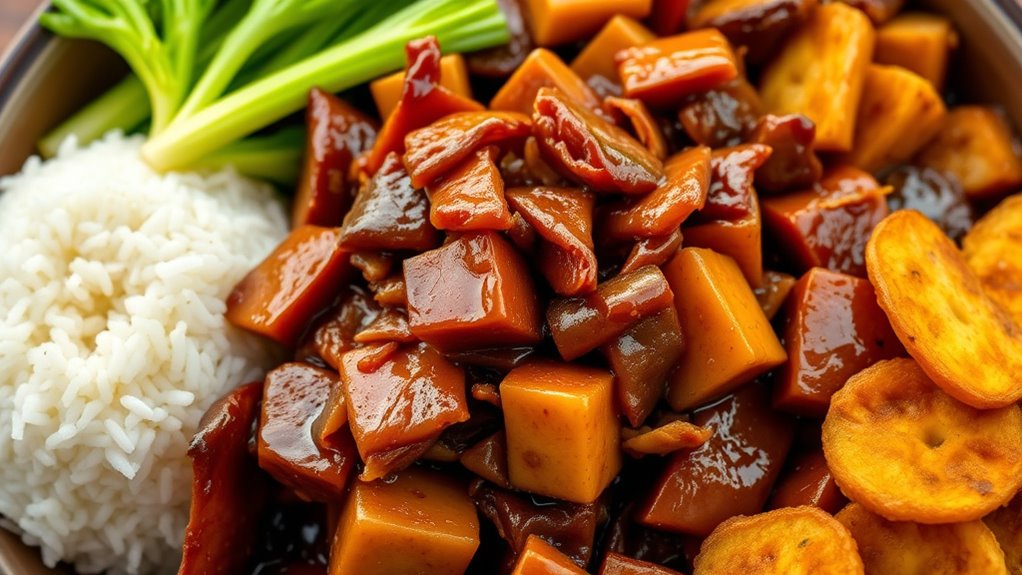
Pairing vegan jackfruit adobo with traditional Filipino sides creates a harmonious and flavorful meal that honors classic culinary roots while embracing plant-based nutrition. To elevate your dining experience, consider serving it with:
- Steamed jasmine rice for a simple, fragrant base
- Sliced seasonal fruit like mango or pineapple for a touch of sweetness
- Pickled vegetables to add tang and crunch
- Freshly grated coconut for richness
- A vibrant salad with local greens for color and freshness
This combination not only enhances the culinary presentation but also balances flavors and textures. The seasonal fruit complements the savory adobo, while the sides add variety and visual appeal. You’ll enjoy a complete, satisfying meal that celebrates Filipino culinary traditions in a modern, vegan way.
Frequently Asked Questions
Can Vegan Jackfruit Adobo Be Made Gluten-Free?
Yes, you can make vegan jackfruit adobo gluten-free by using gluten-free soy sauce or tamari as a soy sauce alternative. For gluten-free substitutions, guarantee all ingredients, like vinegar and spices, are also gluten-free. You’ll still get that rich, savory flavor without gluten. Just swap out traditional soy sauce with a gluten-free option, and your dish stays authentic while being safe for gluten sensitivities.
How Long Does Vegan Jackfruit Adobo Last in the Fridge?
You might find that vegan jackfruit adobo stays fresh in your fridge for about 3 to 4 days. To enjoy it longer, store it in an airtight container. When reheating, do so gently on the stove or microwave until steaming hot, ensuring the flavors stay vibrant. Just a gentle reminder to check for any signs of spoilage before diving in. Proper storage duration and reheating tips keep your dish delightful and safe.
Is Canned Jackfruit Suitable for Authentic Flavor?
Canned jackfruit can be suitable for achieving authentic flavor, especially in vegan dishes like Filipino jackfruit adobo. While fresh jackfruit has a unique texture and taste, canned jackfruit is convenient and widely available, making it a good option for authentic flavor if you choose unseasoned, young green jackfruit. Be sure to drain and rinse it well to remove excess brine, which helps it absorb flavors better and mimic traditional textures.
What Are Some Common Mistakes to Avoid When Cooking?
When cooking, avoid overcrowding the pan, as it can cause uneven cooking and soggy textures. Be careful not to overcook the jackfruit, which can make it mushy and lose flavor. Stir occasionally and cook at the right temperature to maintain its texture. By paying attention to these mistakes, you’ll guarantee your dish has the perfect consistency and authentic taste, especially when preparing flavorful vegan dishes like Filipino jackfruit adobo.
Can This Dish Be Adapted for Other Regional Cuisines?
Imagine turning a local treasure into a global delight—your culinary adaptation. Yes, you can adapt this dish for other regional cuisines by embracing fusion cuisine techniques. Swap key ingredients to match local flavors, like using coconut milk in Thai dishes or spices from Indian cuisine. This approach allows you to create a unique fusion that celebrates diverse culinary traditions while maintaining the dish’s essence.
Conclusion
By choosing vegan jackfruit adobo, you’re embracing a dish rooted in Filipino tradition while supporting sustainability. Did you know that jackfruit requires 90% less water than traditional meat? This makes it not only delicious but also eco-friendly. So, next time you crave comfort food, try this plant-based twist—it’s a flavorful way to honor culture and protect the planet at the same time. Give it a try and enjoy a tasty, sustainable meal!
Hi, I’m Alexander. I’m a vegan of over 20 years, and I initially made the switch for health reasons. However, as time went on, I became more and more passionate about the ethical and environmental implications of leading a vegan lifestyle.
I am the author of The Graceful Kitchen, a vegan blog where I share recipes for delicious and nutritious vegan meals. As someone who is deeply committed to living a cruelty-free life, I am also a strong advocate for using whole foods as the foundation of a healthy diet – and believe that going vegan is one of the best ways to achieve this.










